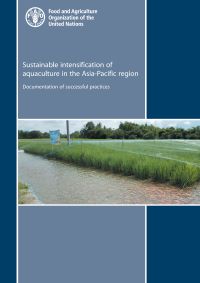Application of aquaculture planning and management tools for sustainable intensification of aquaculture
4 March 2013 | Ramesh Perera | 5539 views | .mp4 | 20.83 MB | Environment and Sustainability
Article 9.1.3 of the Food and Agriculture Organization of the United Nations (FAO) Code of Conduct for Responsible Fisheries states in its principles and articles aimed at promoting best practices for conducting fishing and aquaculture that:
“States should produce and regularly update aquaculture development strategies and plans, as required, to ensure that aquaculture development is ecologically sustainable and to allow the rational use of resources shared by aquaculture and other activities” (FAO 2011).
Ecologically sustainable development (ESD) is a concept that seeks to integrate short and long-term economic, social and environmental effects and values in all decision making (Fletcher et al., 2005). The World Commission on Environment and Development (WCED) defined sustainable development as that which “meets the needs of the present without compromising the ability of future generations, to meet their own needs” ( WCED, 1987).
A related concept more specifically related to aquaculture is ecosystems approach to aquaculture (EAA), defined by the FAO as an approach that:
“strives to balance diverse societal objectives, by taking account of the knowledge and uncertainties of biotic, abiotic and human components of ecosystems including their interactions, flows and processes and applying an integrated approach to aquaculture within ecologically and operationally meaningful boundaries. The purpose of EAA should be to plan, develop and manage the sector in a manner that addresses the multiple needs and desires of societies, without jeopardizing the options for future generations to benefit from the full range of goods and services provided by aquatic ecosystems” (FAO, 2006).
The commercial imperative to intensify aquaculture, due to increasing seafood demand and the finite nature of aquatic resources, presents significant challenges to meeting this goal. This said, the needs of the aquaculture industry and societal objectives of sustainability need not necessarily be at odds, particularly in terms of medium and long-term goals of the aquaculture sector. Ecological sustainability is not solely about environmental protection. It is also about long term commercial viability of a sector that can contribute to food security and bring immense socio-economic benefits. Successful aquaculture relies on maintaining healthy aquatic resources and on the surety of long-term rights of access to these resources. ESD-based planning and management tools have the capacity to deliver of jurisdictional responsibilities for ensuring the sustainable intensification of aquaculture, both in terms of meeting environmental objectives as well as proving industry reliable access to high quality aquatic resources. This paper describes the range of aquaculture planning and management tools that can make up a government jurisdic tion’s planning and management framework for achieving sustainable intensification of aquaculture.
A jurisdiction’s regulatory activities aimed at meeting its ESD objectives for aquaculture fall into five core areas of responsibility: (1) To mitigate environmental impacts; (2) To minimize socio-economic impacts and optimize benefits; (3) To ensure food safety and quality; (4) To manage biosecurity risks (pathogen, pest and genetic risks) associated with aquaculture; and (5) To manage animal welfare. The planning and management tools needed to meet these responsibilities are applied at various points along the aquaculture supply chain, which can be broadly divided into three components:
- Site selection and construction.
- Production (including harvesting).
- Post-harvest processes (including transport, processing and sale).
Public sector tools for planning and managing aquaculture under the above-mentioned five areas of responsibility range from broader licensing and regulator y enforcement systems to specific management tools guided by principles such as ESD and EAA. The tools are discussed under four broad categories: (1) Environmental and socio-economic risk management tools; (2) Food safety and quality; (3) Biosecurity; and (4) Animal welfare.
Environmental and socio-economic risk management tools include aquaculture zoning according to biological carrying capacity, environmental impact assessment (EIA), controlled allocation of farm sites, farm licensing systems, farm audits and monitoring programmes.
Food safety and quality tools include food safety risk assessment, monitoring and control of farm inputs, residue testing, shellfish quality assurance programmes and traceability systems designed to address current and emerging food safety risks.
Biosecurity covers three main areas of concern: pathogen or disease risks, pest (or invasive species) risks, and genetic risks. Tools within this category include quarantine, health certification, disease surveillance and early warning systems, farm reporting/audits, and emergency preparedness and response systems.
Animal welfare focuses on adoption of three animal welfare standards for farmed fish which are now reflected in the Aquatic Animal Health Code of the World Organization for Animal Health (OIE), namely, standards for transport; stunning and killing for human consumption; and killing of fish for disease control purposes.
These specific tools are supported by a range of broader cross-cutting system capacities needed by any jurisdiction to fulfill its responsibilities with respect to ensuring ESD and thereby, the sustainable intensification of aquaculture. These include legal instruments, standard operating procedures, capacity (infrastructure and resourcing, including financial resourcing), and capability (expertise) necessary to implement the specific tools. The single most important tool necessary in all instances is the political vision and leadership to create an environment where the long-term commercial benefits of ESD-based resource management underpinned by good governance are recognized by regulators and the aquaculture industry alike.
Creative Commons Attribution.
